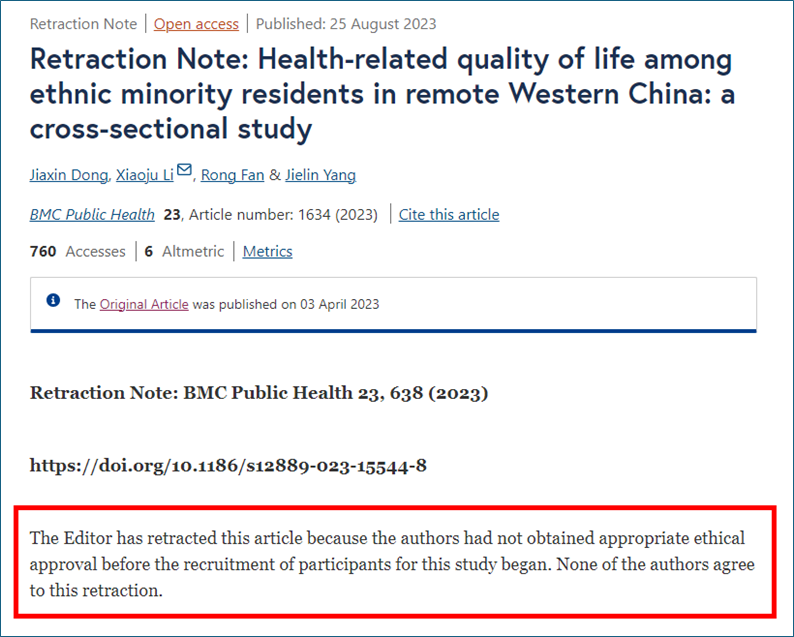In recent years, the number of retracted journal articles has been on the rise. A study published by Nature in 2023 revealed that more than 10,000 research papers were retracted that year—a record high1. Understanding retraction is important for researchers to avoid potential pitfalls and contribute to a more reliable research environment. In this post, we’ll break down the concept of retraction and highlight why it’s important for aspiring researchers to be familiar with it.
What is Retraction?
Retraction is the process of withdrawing a published research paper from the scientific literature. It serves as a crucial mechanism within the research community to address issues related to scientific integrity, accuracy, and credibility. One significant implication of retraction is to allow researchers to rectify errors or misconduct identified in their research; it helps prevent the dissemination of misleading or incorrect information and ensures that future research is not built upon flawed or fraudulent findings. While retraction is generally perceived as a negative occurrence, it also provides authors with a way to take responsibility for their work and maintain their credibility.
Common Reasons for Retraction
Research articles can be retracted for several reasons, including:
1. Plagiarism – it involves the copying of ideas, data, text, or results without proper attribution to the original source. Plagiarism can be either intentional or unintentional.
2. Falsification – it refers to the inappropriate manipulation of data, which can encompass aspects such as images, equipment, or processes, in a manner that does not accurately represent the actual data or findings.
3. Fabrication – intentionally altering data, results, or findings, as well as other aspects of research, including documentation and supporting materials.
4. Erroneous data – this encompasses significant errors or inaccuracies in the data or results, which undermine the validity or reliability of the findings.
5. Duplicated publications – it occurs when an article is published in multiple journals or producing work that’s nearly identical to previously published research without proper acknowledgment or justification.
6. Ethical issues – this includes failure to comply with research ethics requirements, such as the protection of human or animal subjects, conflicts of interest, or failure to obtain proper consent.
It is important to note that these reasons for retraction are not mutually exclusive, and retractions can involve multiple factors. The classification of retractions may vary depending on the specific guidelines or policies of individual publishers/journals/tools (e.g. Nature, Retraction Watch) or research communities.
Why Understanding Retractions Matters?
Understanding retraction, including the retraction policies of publishers and retraction notes, can significantly benefit researchers in publishing their papers. By familiarizing themselves with the retraction policy of a publisher, researchers can ensure that their work meets the ethical and quality standards set forth by the publisher. Additionally, retraction notes can also serve as valuable learning tools, helping researchers avoid mistakes such as misconduct and errors. The following example of a retraction note demonstrates how others can learn from the situation and take necessary precautions to prevent similar ethical problems from arising.

How to Find Retracted Notes?
Various tools are available to help researchers find retracted notes. Scopus and Web of Science are examples of such tools, which allow users to perform a title search beginning with the keywords “Retraction note” or “Retraction notice.” Furthermore, the free web tool Retraction Watch not only collects retractions from existing databases like PubMed or publishers’ sites but also allows users to search based on the specific reasons behind the retractions, such as misconduct, falsification, fabrication, or fake peer reviews.
Conclusion
Retraction plays a vital role in maintaining the integrity, accuracy, and credibility of scientific research. Having a comprehensive understanding of retraction, researchers can ensure that their work adheres to ethical and quality standards while steering clear of potential pitfalls. Engaging with the topic of retraction helps to create a more robust and reliable research landscape for everyone.
Reference
1. Van Noorden, Richard (2023). More than 10,000 research papers were retracted in 2023 – a new record. Retrieved June 29, 2024 from https://www.nature.com/articles/d41586-023-03974-8
Additional Reading
1. Images rights and wrongs. Nature Nanotechnology 5, 627 (2010).
2. Committee on Publication Ethics (COPE) – a resourceful website that provides best practice, guidance, e-learning materials on publication ethics.
3. How you can help improve the visibility of retractions: Introducing NISO’s recommended practice for communication of retractions, removals, and expressions of concern (CREC) / Bakker, Caitlin & Zalm, Maria
4. What To Do Once the Paper is Retracted: NISO Issues Recommended Practice on the Communication of Retractions, Removals, and Expressions of Concern / Todd A Carpenter
– By Kevin Ho, Library
Views: 1123
Go Back to page Top
- Category:
- Academic Publishing
Tags: data manipulation, plagiarism, research integrity, research misconduct, retraction, Retraction Watch
published September 20, 2024


